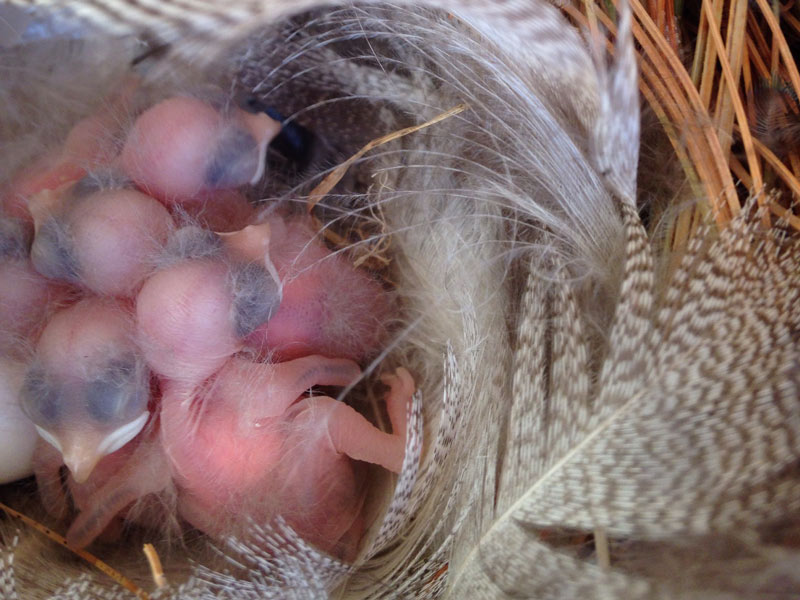
Young tree swallows in a nest box at Sable Oaks Golf Club. Photo courtesy of Matt TenEyck
Here in Maine, a number of cities have prohibited the use of pesticides and synthetic fertilizers for commercial, residential and city-owned properties, and more cities have similar restrictions in the works. Such a ban has been approved in South Portland, Maine, under which only “organic” pesticide and fertilizer options will be permitted. The ban will apply to city property beginning next May, and will extend to private property in May 2018.
Those who proposed and support South Portland’s pesticide ban are simply trying to implement sound agronomy. Yet as superintendents know, such a thing doesn’t happen overnight — especially somewhere like Sable Oaks Golf Club, which was built on an old pig farm and is 100 percent straight gray clay. Without the tools science has provided us for managing and maintaining our courses, turfgrass decline would be inevitable.
Fortunately, although the course will eventually be subject to the pesticide ban, because of its commitment to the environment, Sable Oaks — the only privately owned course in South Portland — was given extra time to make adjustments to comply with the restrictions (until May 2019), and also achieved certain exemptions.
How was the course able to buy more time to make the transition, and gain some leniency?
My personal goal in the golf course management industry has been to be an environmental steward, and throughout my decade as superintendent at Sable Oaks, I took on projects and practices — most of all, integrated pest management (IPM) — to meet that objective. Shortly after I started, our landscaper, Al Hardy, became my mentor, and the first lesson he taught me was that milkweed is not a weed. Under Al’s guidance, we planted butterfly gardens, reared and released beetles for the biological control of purple loosestrife, and managed 40 bird boxes for Audubon certification.
When South Portland decided to tackle the cleanup of Long Creek, a heavily polluted body of water that runs through Sable Oaks, I seized the opportunity to be involved — to be proactive rather than reactive. I made it my goal for the water exiting the course to be cleaner than it was when it entered. The Long Creek restoration team installed three water monitoring stations on the course, and we increased our buffer zones, installed riparian zones, and created no-spray zones and no-maintenance areas. All of these steps worked, and the golf course, which had been a small contributor to the creek’s pollution to begin with, is now actually a tool for cleaning it.
Sable Oaks also became involved in annual bluegrass weevil (ABW) research with Stan Swier, who was an entomologist at the University of New Hampshire at the time. The course became a test plot for bringing Acelepryn to market, and that led to involvement with WeevilTrak, where we would monitor degree days and phenological indicators, and send samples to Stan. He would then tell us what to spray and when. We had such success that we were eventually pulled from WeevilTrak because our samples were larva-less — we had eradicated ABW. That’s IPM in action.
Throughout all of these projects, I surrounded myself with industry professionals, local conservation commissions, university experts and environmental liaisons, such as FB Environmental, Audubon International and the Biodiversity Research Institute. One of these professionals, Jesse O’Brien, an instructor at the University of Maine and a member of the Maine IPM Council, brought Sable Oaks to the table when South Portland hit the radar for a pesticide prohibition.
We enlisted the help of RISE (Responsible Industry for a Sound Environment), which set up a website, sent out mailers, made door hangers, and supported Sable Oaks in hosting an IPM field day, where we could have one-on-one communication with city council members and show them up close how IPM works. This event was a turning point for us, and when it came time for the city council to vote on the pesticide ban, they pushed back Sable Oaks’ required compliance date, and the course will still be able to use pesticides on greens and tees provided it continues to employ IPM, with the goal of continuing to reduce pesticide use over time.
This huge achievement wouldn’t have been possible without all of those who’ve offered advice and support for Sable Oaks’ environmental pursuits throughout the years. Current Sable Oaks superintendent David D’Andrea could potentially earn even more leniency regarding South Portland’s pesticide ban as he continues to oversee a conscientiously managed, environmentally sound golf course operation.
Matt TenEyck is the golf course superintendent at Salmon Falls Resort in Hollis, Maine, and an 11-year member of GCSAA. He was the superintendent at Sable Oaks Golf Club in South Portland, Maine, for 10 years.